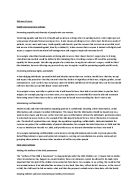Right to protection from danger and harm:
Care workers should do everything in their power to protect service users from danger and/or harm. This danger can be physical, for example punching, kicking, restraining someone unnecessarily, or handling people roughly when helping them with bathing, moving or using the toilet; sexual, for example doing things to a person without their consent; psychological, for example humiliating someone or harassing them; financial, for example stealing their money or possessions, or putting pressure on someone to give you money. Those most at risk from danger and harm are children, individuals with mental health problems, individuals with learning disabilities or physical disabilities, the elderly etc., as these kinds of people can be less powerful and easily influenced. Care workers can protect individuals from danger and harm by raising awareness of possible abuse or problems, monitoring who they have contact with, physically or written (e.g. who phones them, who they write to, who cares for them etc.), by training staff so they know what procedures to follow when they feel someone’s safety might be at risk etc.
Right to access information relevant to themselves:
Service users have the right to know what is being recorded and said about them and should be able to request any information that has been recorded about them at any time. For example in a school, a parent should be able to request to view, and be allowed to view, the records that the school have kept about their child, or children, regarding their health, their progress at the school, and incidents that have occurred etc. This comes under the Data Protection Act 1998.
Right to communicate using their preferred methods of communication and language:
The right to communicate using their preferred methods is vital to health and social care work. Effective communication is essential because it is imperative that everybody is provided with the necessary information that they need, so the communication must be concise and clear. The practitioners must communicate effectively in order to gain and share information about the patient and discuss care plans. Without effective communication the practitioners cannot engage productively with each other, resulting in the patient possibly receiving the wrong care, and the needs of the patient may not be met. The patient must also engage in effective communication with practitioners to ensure that we know what their needs are, and how they are feeling. They must feel comfortable with the practitioner and build mutual trust and respect in order for them to be cared for properly.
A patient may choose to speak to someone in their first language, in which case they are entitled to a translator so that they can effectively communicate with the other person, for example a patient talking to a doctor. Another example would be someone who uses a different method other than speaking, for example Makaton, or British Sign Language. Their right to do this is so important to ensure they can effectively communicate and receive the care and services that they need.
Right to be cared for in a manner that takes account of their needs, choices, preferences:
Care workers should aim to treat each person they care for as an individual, and provide care to that person that meets their individual needs, by assessing each person to find out their particular needs, taking into account their beliefs and preferences. For example an elderly resident in a care home may need help with bathing and personal cleaning, but may be perfectly capable of eating independently, therefore care workers in that setting should accept that and provide help where necessary but allow independence where the service user wants it. If that person’s religion restricts physical contact with the opposite gender for example, then the person should be allowed a person of the same gender to help them when bathing, this would be respecting their choices and preferences.








